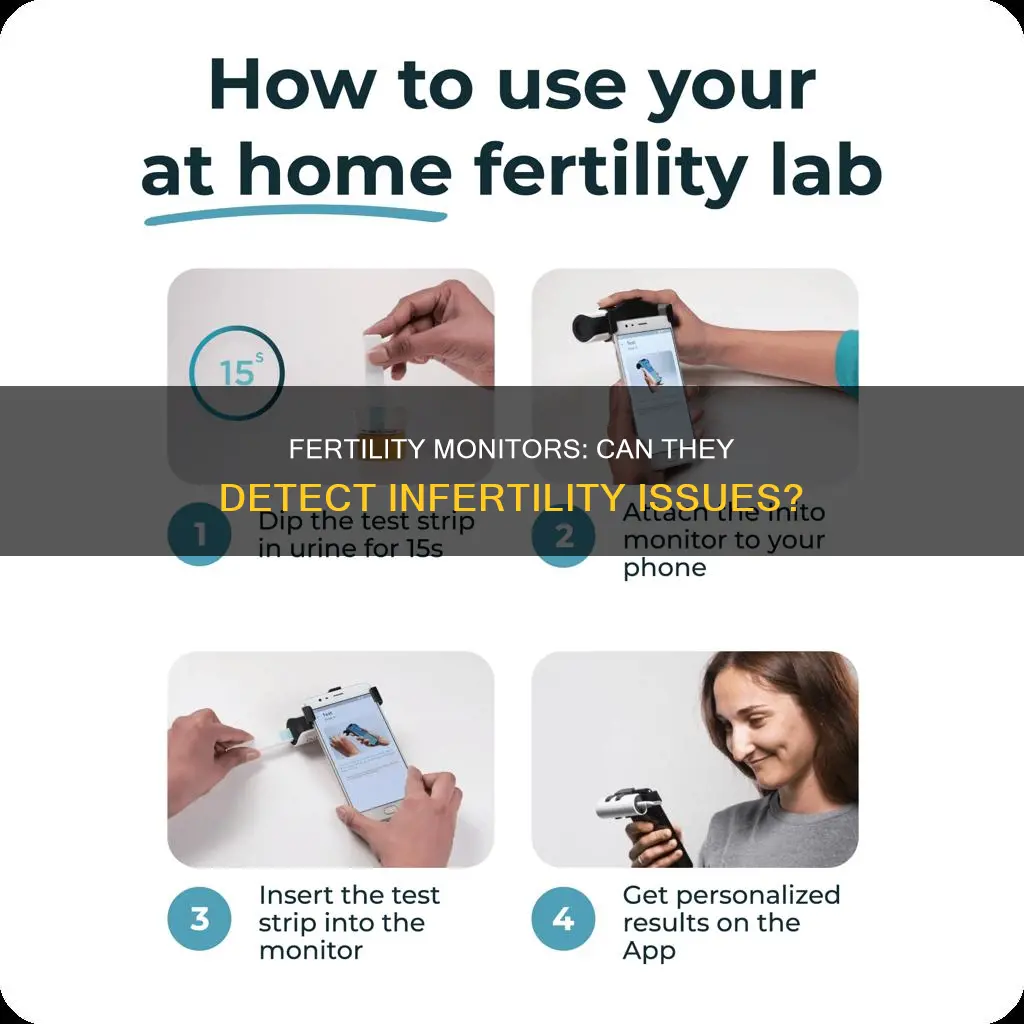
Fertility monitors are devices that help individuals identify their fertile days and track their menstrual cycles. They work by measuring hormone levels in urine, basal body temperature, cervical mucus, or a combination of these metrics. While these monitors can help increase the chances of getting pregnant, they do not guarantee conception. They are also not intended to be used as a method of contraception.
Fertility monitors are especially useful for those who want to get pregnant and plan their fertilization well. They can also be helpful for those with irregular cycles, as they provide a simple and quick way to determine fertility. However, it's important to note that fertility monitors may not be suitable for everyone, and they should not replace consultations with healthcare professionals.
| Characteristics | Values |
|---|---|
| Purpose | To help people who are trying to conceive by tracking their fertile days and telling them when ovulation starts. |
| Mechanism | Fertility monitors measure levels of hormones in urine, basal body temperature (BBT), cervical mucus, or some combination of these three metrics. |
| Types | Wearable monitors, vaginal monitors, urine-testing monitors, basal body thermometers. |
| Effectiveness | Fertility monitors are not 100% accurate or foolproof, nor do they guarantee conception. |
What You'll Learn

How do fertility monitors work?
There are several types of fertility monitors, and they work in different ways. However, they all rely on taking readings of your basal body temperature (BBT), cervical mucus, or urine-based hormone levels. Here's a breakdown of how each type works:
Wearable monitors
Wearable monitors are usually bands worn on the upper arm or wrist overnight. They track your BBT, which rises soon after ovulation, confirming that ovulation has occurred. Over time, they can help accurately predict your fertile window by tracking your BBT patterns. An example of a wearable monitor is the Tempdrop Fertility and Ovulation Tracker.
Vaginal monitors
Vaginal monitors, such as the kegg Fertility Tracker, are inserted into the vagina for a set period. They measure the quality of cervical mucus, which gets thicker and more mucus-like as ovulation approaches. By tracking this, the monitor can alert you to increased fertility, helping you avoid or achieve pregnancy.
Urine-testing monitors
Urine-testing monitors, like the Clearblue Fertility Monitor, typically use a set of urine test strips and an electronic reading device. After dipping the test strip into your urine sample, you insert it into the device, and it provides results by tracking your hormone levels. These monitors can track luteinizing hormone (LH), estrogen, and sometimes progesterone levels to determine your place in your cycle.
Basal body thermometers
Basal body thermometers work similarly to wearable monitors but without the wearable device. You take your temperature orally with a thermometer first thing in the morning before getting out of bed. While less convenient than wearable monitors, they are a more affordable option. An example is the iProven Digital Basal Thermometer.
The Ultimate Guide to Updating Your ASUS 144Hz Monitor
You may want to see also

What are the different types of fertility monitors?
There are several types of fertility monitors available, which work by measuring levels of hormones in your urine, basal body temperature (BBT), cervical mucus, or some combination of these three metrics. Here is a list of the different types of fertility monitors:
- Wearable monitors: These monitors are usually worn on the upper arm or wrist overnight, so you don't have to remember to take your BBT when you wake up. As your basal body temperature rises soon after ovulation, this monitor is useful for confirming that ovulation has occurred. Over time, wearable monitors can help you more accurately track your cycles and predict your fertile window.
- Vaginal monitors: Vaginal monitors are inserted into the vagina for a set length of time and are designed to measure the quality of your cervical mucus. They alert you to increased fertility, signalling when it's time to avoid or try to achieve pregnancy.
- Urine-testing monitors: This type of monitor requires a set of urine test strips and an electronic reading device. After dipping the stick in your urine sample, you insert it into the device and wait for the results. Depending on the device, you may be able to track your LH, progesterone, and estrogen levels to determine where you are in your cycle.
- Basal body thermometers: This type of monitor works similarly to a wearable monitor, except it is not worn on the body. You take your temperature orally first thing in the morning before getting out of bed, in the same way you would with a regular oral thermometer. While less convenient than a wearable device, it is much less expensive.
Monitoring Power Usage: RV Hookup Management
You may want to see also

Do fertility monitors work?
Fertility monitors do work, but they are not 100% accurate. They can help to increase the chances of getting pregnant by pinpointing the best times for intercourse. They can also be used to avoid conception without using birth control.
There are several types of fertility monitors, including wearable monitors, vaginal monitors, urine-testing monitors, and basal body thermometers. Each type of monitor measures different fertility indicators, such as hormones in urine, basal body temperature (BBT), cervical mucus, or a combination of these metrics.
Wearable monitors are usually worn on the upper arm or wrist overnight and help to confirm ovulation by tracking BBT. Vaginal monitors are inserted into the vagina to measure the quality of cervical mucus. Urine-testing monitors use test strips to detect the presence of hormones such as luteinizing hormone (LH), estrogen, and progesterone in urine. Basal body thermometers measure BBT orally, similar to a regular thermometer.
The accuracy of fertility monitors depends on the type of monitor and the consistency of use. LH testing strips are generally considered the most accurate way to pinpoint the fertile window, with a claimed accuracy rate in the high 90s. However, no monitor can guarantee conception or prevent pregnancy, and outside factors such as lack of sleep, illness, or reproductive issues can affect their accuracy.
When choosing a fertility monitor, it is important to consider factors such as ease of use, accuracy, speed of results, consistency, and value. It is also important to prioritize simplicity and accuracy over cost and type. Consulting with a healthcare professional can help individuals select the most suitable fertility monitor for their needs.
Monitoring Controlled Drug Usage: Insurance Companies' Role and Reach
You may want to see also

How to choose the best fertility monitor
Fertility monitors can be a great way to help you understand your body and menstrual cycle, and they can be especially useful if you're trying to get pregnant or want to avoid pregnancy without using birth control.
- Consider your preferences for testing methods: Fertility monitors can track your basal body temperature (BBT), cervical mucus, or hormone levels in your urine. Decide which method you prefer and choose a monitor that measures the data you're interested in.
- Think about your lifestyle: Some monitors require daily tests, while others prompt testing on specific days. Choose a monitor that fits your schedule and routine. For example, if you have an irregular schedule, a wearable monitor that tracks your BBT while you sleep might be a good option.
- Evaluate cost and convenience: Fertility monitors vary in price, and some require the additional purchase of testing strips. Consider your budget and how much you're willing to spend on the device and any necessary accessories.
- Assess your desired level of detail: Decide how detailed you want your data to be and whether you want to use an app to track and interpret the information. If you have irregular cycles or health conditions, choose a monitor that suits your specific needs.
- Consult a healthcare professional: If you have concerns about your fertility or are trying to conceive, it's always best to speak with a doctor or fertility specialist. They can guide you in selecting the most suitable fertility monitor and provide additional advice and support.
- Best overall: The Mira Starter Kit measures urinary progesterone, luteinizing hormone, and estrogen with 99% accuracy and connects to an app for data tracking.
- Best intravaginal monitor: The OvuSense Advanced Fertility Monitor tracks your cycle and measures progesterone levels to confirm ovulation. It's a good option for people with irregular cycles.
- Best thermometer monitor: The Femometer Vinca 2.0 Digital Basal Thermometer measures your morning temperature accurately and connects to an app to track your menstrual cycle and hormone indicators.
- Best budget option: The Easy@Home Ovulation Test Kit includes 25 ovulation test strips and 10 pregnancy test strips at an affordable price.
Remember, fertility monitors are not 100% accurate, and they don't guarantee conception or prevent pregnancy. They are a tool to help you understand your body and fertility, and consulting a healthcare professional is always recommended for personalized advice.
LCD TVs: The Pros and Cons as PC Monitors
You may want to see also

When to see a doctor about fertility issues
Fertility monitors can be a great way to help you understand your body and your cycle, and they can be especially useful if you have irregular cycles. However, they are not always 100% accurate and they don't guarantee conception. If you are concerned about your fertility, it's always a good idea to speak to a healthcare professional. Here are some signs that it might be time to see a doctor about fertility issues:
- You are under 35 and have been trying to conceive for a year or longer without success.
- You are over 35 and have been trying for six months without success.
- You are over 40 and want to get pregnant. In this case, it is recommended to see a doctor after three months of trying.
- You have a known reproductive issue, such as polycystic ovary syndrome (PCOS), endometriosis, uterine fibroids, or primary ovarian insufficiency (POI).
- You have a thyroid condition.
- You have had multiple miscarriages.
- You have been diagnosed with cancer.
- You have irregular periods, no period, or heavy bleeding.
- You or your partner has a history of sexually transmitted infections (STIs).
- You have a chronic medical condition.
If you are trying to conceive and are experiencing any of these issues, it is recommended that you seek advice from a fertility specialist or your doctor. They can help determine if there is an identifiable cause for your fertility issues and provide appropriate treatment options.
Connecting a Monitor to a Laptop Using HDMI Cable
You may want to see also
Frequently asked questions
Fertility monitors work by measuring levels of hormones in your urine, basal body temperature (BBT), cervical mucus, or some combination of these three metrics.
There are several types of fertility monitors, including wearable monitors, vaginal monitors, urine-testing monitors, and basal body thermometers.
Fertility monitors can help increase the likelihood of getting pregnant by pinpointing the best times for intercourse. They can also be used to avoid conception without using birth control. Additionally, fertility monitors can help individuals get to know their bodies better and track their menstrual cycles.
While fertility monitors can provide valuable insights, they are not 100% accurate or foolproof. The experts interviewed in one source say that luteinizing hormone (LH) testing strips are generally the most accurate way to pinpoint the fertile window. However, no monitor can guarantee conception or prevent pregnancy, and outside factors such as lack of sleep, illness, or reproductive issues can interfere with the data.







